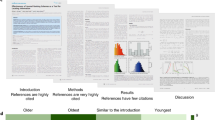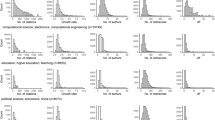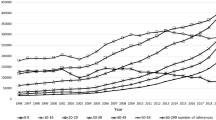Abstract
The purpose of this study was to assess the gamma distribution as a model of the distribution of ages of cited references in corpora of scientific literature, and to derive inferences from the parameters of the distributions. The ages of cited references in 2867 articles published in 40 distinguished journals in the fields of accounting, economics, finance, management, marketing, operations and information systems, organisation behaviour and human resources were analysed. The distributions of ages of cited references in each subject area were fitted to gamma distributions with the parameters estimated using minimum distance estimation. In contrast to extant literature, it is shown for all subject areas in the study that the goodness-of-fit statistics for gamma distributions were superior to those for lognormal distributions. The rate of growth of knowledge and the temporal profile of the growth of knowledge are derived from the parameters of the gamma distributions and differentiate the subject areas. Longitudinal analysis demonstrates that the gamma distribution models are stable but illustrate the evolution of specific corpora of literature over time. The gamma distribution parameters and derived metrics can be applied diagnostically and descriptively to characterise corpora of literature, or prospectively to set norms, expectations and criteria for new research. The results have implications for future bibliometric studies, authors, editors, reviewers, and knowledge researchers. Opportunities for further research and verification of prior research are created from this novel bibliometric approach.






Similar content being viewed by others
Availability of data and material
All data used in the study is in the public domain.
Code availability
Not applicable.
References
Azevedo, H. V. F., & de Lima Junior, E. T. (2019). Statistical inference techniques applied to large samples. In Paper presented at the XL Ibero-Latin-American Congress on Computational Methods in Engineering, Natal, Rio Negro, Brazil.
Baird, G. L., & Harlow, L. L. (2016). Does one size fit all? A case for context-driven null hypothesis statistical testing. Journal of Modern Applied Statistical Methods, 15(1), 100–122.
Bertin, M., Atanassova, I., Gingras, Y., & Larivière, V. (2016). The invariant distribution of references in scientific articles. Journal of the Association for Information Science and Technology, 67(1), 164–177.
Birch, S. (1877). Our portrait gallery. Dublin University Magazine, 1833–1877, 90(535), 54–60.
Börner, K., Maru, J. T., & Goldstone, R. L. (2004). The simultaneous evolution of author and paper networks. Proceedings of the National Academy of Sciences, 101(suppl 1), 5266–5273.
Brookes, B. C. (1972). The aging of scientific literature. In A. I. Chernyi (Ed.), Problems of information science: Collection of papers (Vol. FID-478, pp. 66–90). The Hague: International Federation for Documentation.
Burrel, Q. L. (2001). Stochastic modelling of the first-citation distribution. Scientometrics, 52(1), 3–12.
Burrell, Q. (2002a). Modelling citation age data: Simple graphical methods from reliability theory. Scientometrics, 55(2), 273–285.
Burrell, Q. (2002b). The n’th-citation distribution and obsolescence. Scientometrics, 53(3), 309–323.
Burton, R. E., & Kebler, R. (1960). The “half-life” of some scientific and technical literatures. American Documentation, 11(1), 18–22.
Cairns, R. B. (1979). Social development: The origins and plasticity of interchanges. San Francisco: WH Freeman.
Chatfield, C. (1995). Problem solving: A statistician’s guide (2nd ed.). Boca Raton, Florida: CRC Press.
Chen, C. (2003). On the shoulders of giants. Mapping scientific frontiers: The quest for knowledge visualization (pp. 135–166). London: Springer.
Clauset, A., Shalizi, C. R., & Newman, M. E. (2009). Power-law distributions in empirical data. SIAM Review, 51(4), 661–703.
Cole, S. (1983). The hierarchy of the sciences? American Journal of Sociology, 89(1), 111–139.
de Solla Price, D. J. (1965). Networks of scientific papers. Science, 149, 510–515.
de Solla Price, D. J. (1970). Citation measures of hard science, soft science, technology, and nonscience. In C. E. Nelson & D. K. Pollock (Eds.), Communication among scientists and engineers (pp. 3–22). Lexington, MA: D.C. Heath and Company.
Egghe, L. (1984). Stopping time techniques for analysts and probabilists (Vol. 100). Cambridge: Cambridge University Press.
Egghe, L. (1997). Price index and its relation to the mean and median reference age. Journal of the American Society for Information Science, 48(6), 564–573.
Egghe, L., & Ravichandra Rao, I. K. (1992). Citation age data and the obsolescence function: Fits and explanations. Information Processing and Management, 28(2), 201–217.
Egghe, L., & Rousseau, R. (1990). Introduction to informetrics: Quantitative methods in library, documentation and information science. Amsterdam: Elsevier Science Publishers.
Förster, M., Stelzer, B., & Schiebel, E. (2018). Stochastic analysis of citation time series of emergent research topics. In Paper presented at the 23rd international conference on science and technology indicators, Leiden University, The Netherlands.
Frontline Systems Inc. (1990–2009). Solver add-in. Incline Village, Nevada. Retrieved from http://www.solver.com.
Glänzel, W. (2004). Towards a model for diachronous and synchronous citation analyses. Scientometrics, 60(3), 511–522.
Gross, P. L., & Gross, E. M. (1927). College libraries and chemical education. Science, 66(1713), 385–389.
Gupta, B. (1997). Analysis of distribution of the age of citations in theoretical population genetics. Scientometrics, 40(1), 139–162.
Hamermesh, D. S. (2018). Citations in economics: Measurement, uses, and impacts. Journal of Economic Literature, 56(1), 115–156.
Hedges, L. V. (1987). How hard is hard science, how soft is soft science? The empirical cumulativeness of research. American Psychologist, 42(5), 443.
Hu, X., Li, X., & Rousseau, R. (2020). Describing citations as a function of time. Journal of Data and Information Science, 5(2), 1–12.
Jarić, I., Knežević-Jarić, J., & Lenhardt, M. (2014). Relative age of references as a tool to identify emerging research fields with an application to the field of ecology and environmental sciences. Scientometrics, 100(2), 519–529.
Kaplan, M. A. (1961). Problems of theory building and theory confirmation in international politics. World Politics, 14(1), 6–24.
Krauze, T. K., & Hillinger, C. (1971). Citations, references and the growth of scientific literature: A model of dynamic interaction. Journal of the American Society for Information Science, 22(5), 333–336.
Kuhn, T. S. (1962). The structure of scientific revolutions. Chicago: University of Chicago Press.
Lin, M., Lucas, H. C., Jr., & Shmueli, G. (2013). Research commentary—too big to fail: Large samples and the p-value problem. Information Systems Research, 24(4), 906–917.
Lofland, J. (1967). Notes on naturalism in sociology. Kansas Journal of Sociology, 3(2), 45–61.
MacRae, D., Jr. (1969). Growth and decay curves in scientific citations. American Sociological Review, 34(5), 631–635.
Matricciani, E. (1991). The probability distribution of the age of references in engineering papers. IEEE Transactions on Professional Communication, 34(1), 7–12.
McMaster University. (2020). Research guides. Retrieved from https://libguides.mcmaster.ca/ft-top50.
Meehl, P. E. (1978). Theoretical risks and tabular asterisks: Sir Karl, Sir Ronald, and the slow progress of soft psychology. Journal of Consulting and Clinical Psychology, 46(4), 806–834.
Mees, C. K. (1917). The production of scientific knowledge. Journal of Industrial and Engineering Chemistry, 9(12), 1137–1141. https://doi.org/10.1021/ie50096a027.
Nakamoto, H. (1988). Synchronous and diachronous citation distributions. Informetrics, 87(88), 157–163.
Nowak, S. (1977). The formulation of the research problem and the choice of the right methods. Methodology of sociological research (pp. 1–42). Dordrecht: Springer.
Pan, R. K., Petersen, A. M., Pammolli, F., & Fortunato, S. (2018). The memory of science: Inflation, myopia, and the knowledge network. Journal of Informetrics, 12(3), 656–678.
Pollman, T. (2000). Forgetting and the ageing of scientific publications. Scientometrics, 47(1), 43–54.
Popper, K. (2014). Conjectures and refutations: The growth of scientific knowledge. London: Routledge.
Ransom, J. C. (1939). The arts and the philosophers. The Kenyon Review, 1(2), 194–199.
Redner, S. (2005). Citation statistics from 110 years of physical review. (pp. 1–7) arXiv preprint: physics/0506056.
Small, H. (1999). ASIS award of merit: On the shoulders of giants. Bulletin of the American Society for Information Science, 25, 23–25.
Stacey, A. G. (2020). Robust parameterisation of ages of references in published research. Journal of Informetrics, 14(3), 1–19. https://doi.org/10.1016/j.joi.2020.101048.
Storer, N. W. (1967). The hard sciences and the soft: Some sociological observations. Bulletin of the Medical Library Association, 55(1), 75–84.
Yin, Y., & Wang, D. (2017). The time dimension of science: Connecting the past to the future. Journal of Informetrics, 11(2), 608–621.
Funding
No specific funding was received for this research.
Author information
Authors and Affiliations
Corresponding author
Ethics declarations
Conflicts of interest
The author has no conflicts of interest.
Rights and permissions
About this article
Cite this article
Stacey, A.G. Ages of cited references and growth of scientific knowledge: an explication of the gamma distribution in business and management disciplines. Scientometrics 126, 619–640 (2021). https://doi.org/10.1007/s11192-020-03761-6
Received:
Published:
Issue Date:
DOI: https://doi.org/10.1007/s11192-020-03761-6




